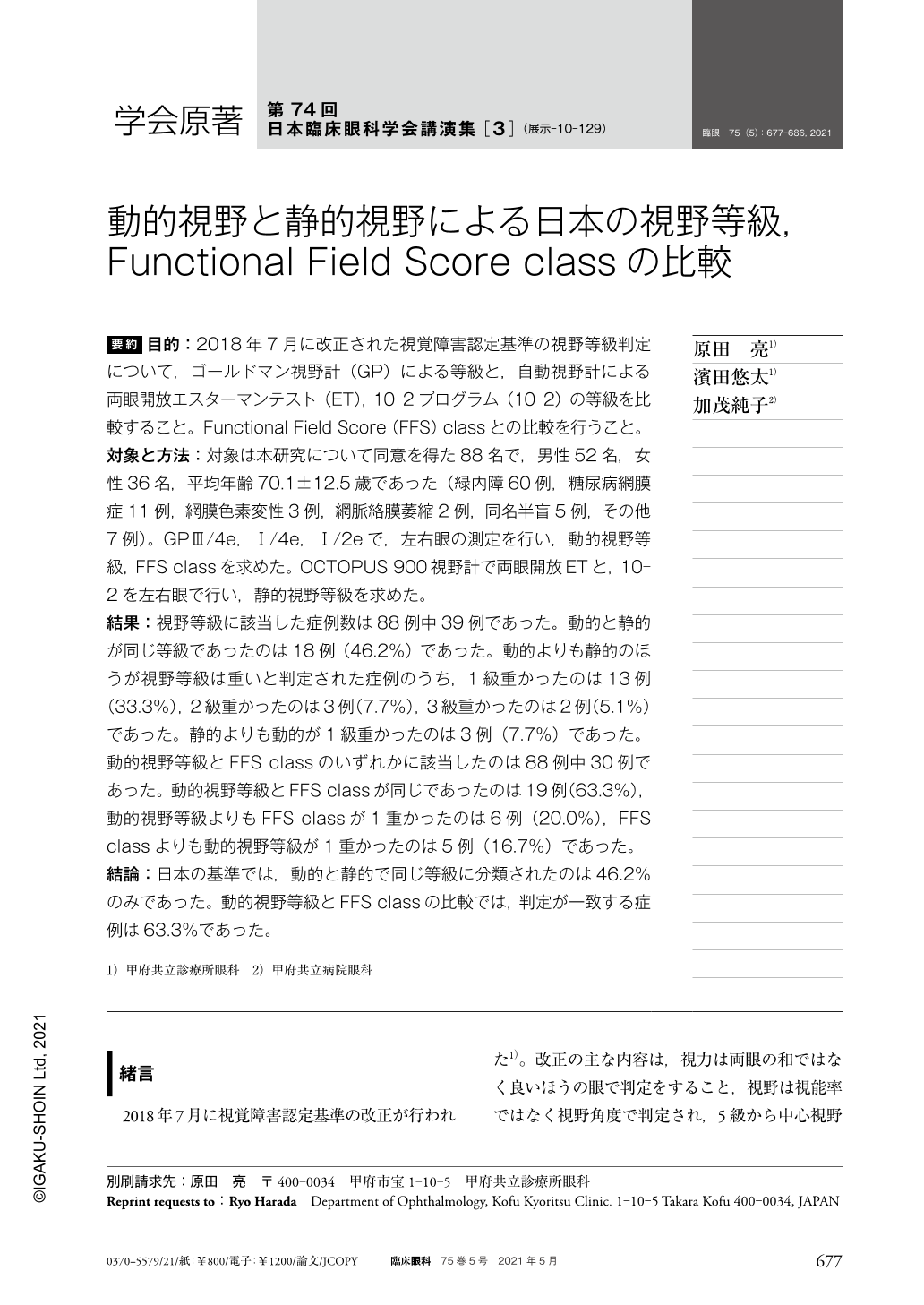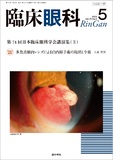Japanese
English
- 有料閲覧
- Abstract 文献概要
- 1ページ目 Look Inside
- 参考文献 Reference
要約 目的:2018年7月に改正された視覚障害認定基準の視野等級判定について,ゴールドマン視野計(GP)による等級と,自動視野計による両眼開放エスターマンテスト(ET),10-2プログラム(10-2)の等級を比較すること。Functional Field Score(FFS)classとの比較を行うこと。
対象と方法:対象は本研究について同意を得た88名で,男性52名,女性36名,平均年齢70.1±12.5歳であった(緑内障60例,糖尿病網膜症11例,網膜色素変性3例,網脈絡膜萎縮2例,同名半盲5例,その他7例)。GPⅢ/4e,Ⅰ/4e,Ⅰ/2eで,左右眼の測定を行い,動的視野等級,FFS classを求めた。OCTOPUS 900視野計で両眼開放ETと,10-2を左右眼で行い,静的視野等級を求めた。
結果:視野等級に該当した症例数は88例中39例であった。動的と静的が同じ等級であったのは18例(46.2%)であった。動的よりも静的のほうが視野等級は重いと判定された症例のうち,1級重かったのは13例(33.3%),2級重かったのは3例(7.7%),3級重かったのは2例(5.1%)であった。静的よりも動的が1級重かったのは3例(7.7%)であった。動的視野等級とFFS classのいずれかに該当したのは88例中30例であった。動的視野等級とFFS classが同じであったのは19例(63.3%),動的視野等級よりもFFS classが1重かったのは6例(20.0%),FFS classよりも動的視野等級が1重かったのは5例(16.7%)であった。
結論:日本の基準では,動的と静的で同じ等級に分類されたのは46.2%のみであった。動的視野等級とFFS classの比較では,判定が一致する症例は63.3%であった。
Abstract Purpose:To compare the measurements of the Goldmann perimeter(GP)and the binocular Esterman test(ET), 10-2 program(10-2)with an automatic perimeter for the visual field classification of the visual impairment certification standard revised in July 2018. To compare with Functional Field Score(FFS)class.
Subject and method:The subjects were 88 patients who consented to this study, 52 males, 36 females, and average age 70.1±12.5 years(glaucoma, 60 cases;diabetic retinopathy, 11 cases;retinitis pigmentosa, 3 cases;chorioretinal atrophy, 2 cases;homonymous hemianopia, 5 cases;others, 7 cases). The right and left eyes were measured using GPⅢ/4e, Ⅰ/4e, and Ⅰ/2e, and the kinetic visual field grade and FFS class were classified. Binocular ET and 10-2 were measured with the right and left eyes using the OCTOPUS 900 perimeter, and the static visual field grades were classified.
Results:The number of cases classified as visual field impairment were 39 out of 88. 18 cases(46.2%)had the same grade of kinetic and static classifications. Of the cases in which the visual field grade was classified heavier by static than by kinetic, 13 cases(33.3%)were 1 grade heavier, 3 cases(7.7%)were 2 grades heavier, and 2 cases(5.1%)were 3 grades heavier. In 3 cases 1 grade heavier by kinetic than static(7.7%). Thirty out of 88 cases corresponded to either the kinetic visual field grade or the FFS class. The kinetic visual field grade and FFS class were the same in 19 cases(63.3%), the FFS class was 1 heavier than the kinetic visual field grade in 6 cases(20%), and the kinetic visual field grade was 1 heavier than the FFS class in 5 cases(16.7%).
Conclusion:By Japanese standards, only 46.2% classified in the same class by the kinetic and static visual field testings. Comparing the kinetic visual field grade and the FFS class, 63.3% of the cases had the same classification.

Copyright © 2021, Igaku-Shoin Ltd. All rights reserved.


